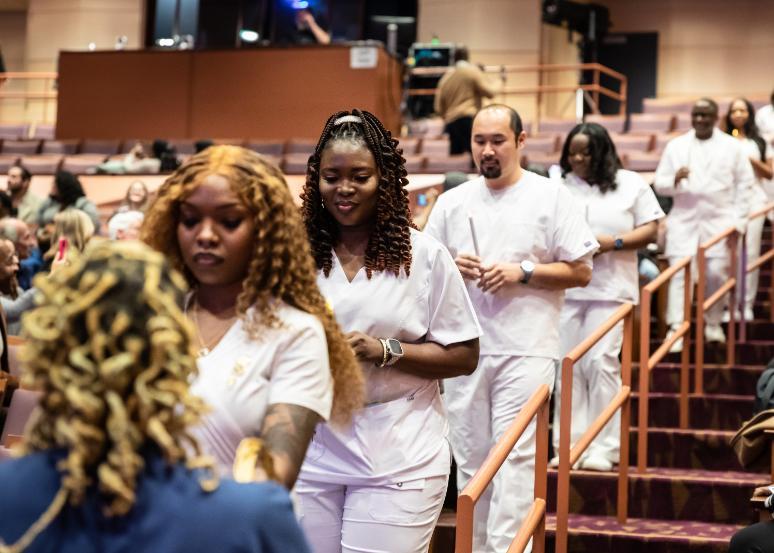Written by: Jazmine Steele
Senior Writer, Office of Communications

The Prince George’s Community College nursing program is on the mend after weathering several challenges, including the COVID-19 pandemic. From 2018-2019, the program faced declines in National Council Licensure Exam (NCLEX) pass rates, possible accreditation loss, and Maryland State Board approval. New faculty, varied learning models, and significant grant dollars have given the program new life.
“My whole first year as the department chair was spent trying to work with the Maryland Board of Nursing to get us back on track,” Vivian Kuawogai, PGCC nursing department chair, said. “Now, we’re back on track.”
In December 2023, the program honored 32 new graduates at the nurse pinning ceremony and those students are prepared to advance in their careers by taking the NCLEX.
Kuawogai is proud that in the last two years, program graduates have performed above the required 80 percent benchmark for first-time NCLEX testers. The fall 2022 and spring 2023 registered nurse graduates had 100 percent NCLEX pass rates as well as the summer 2022 and summer 2023 licensed practical nurse certificate graduates.
She credits the PGCC faculty, staff, administration, student support services, and the Prince George’s Community College Foundation, Inc. for their immense support of the program.
“In order to have a successful program, you have to have the wraparound support from administration and the College has been extremely supportive since I have been the department chair,” she said. “They have bent over backward to help us do what we need to do to educate our students.”
In 2019, Kuawogai accepted the role of nursing department chair at PGCC. She has been with the College for over 20 years and pulled from her 42 years of career experience in nursing education and public health to lead the College to improved conditions.
“I saw a great need here,” she said. “It was everything from working with students like myself who are immigrants, to students with significant language difficulties, as well as a wide age range of students.”
The program underwent significant changes to address the personal and social challenges that may inhibit student success. Grant dollars from the Maryland Higher Education Commission’s Nurse Support Program II and the Health Resources and Services Administration afforded the program the ability to hire new faculty with salary incentives and retention bonuses.
In fall 2023, the program added an evening and weekend cohort. New faculty to staff that program are currently in the hiring process. The nursing continuing education programs are being expanded to the Laurel campus and new equipment has been purchased for the University Town Center campus as well.
“When you go to hospitals around the DMV, you will be amazed at how many nursing graduates from the PGCC program are staffing hospitals and doing advanced practice work,” she said.
Kuawogai reasons that COVID revealed flaws within the public health care system and caused many nurses to exit early or reconsider the profession. She believes that the pandemic accelerated a nurse staffing shortage that was already projected to impact the U.S. by 2030.
“It was very clear nurses were the frontline workers along with the EMTs who brought the patients to them,” she said. “Because they didn’t have adequate PPE, a lot of nurses got infected and we lost a lot of nurses. Many nurses suffered severe trauma because they saw a lot more death than they had planned to.”
Although these factors have caused a strain on the profession, nurses understand the patience and compassion necessary to repair fractured systems. Kuawogai has high hopes for the future. She would like to see the PGCC nursing program offer a bachelor's degree program as well as a middle college experience for high school students to engage in the profession early. For Kuawogai, it is important to empower the next generation of nurses to lead healthy communities.
“In nursing, we say that nurses are the managers of the patient’s care,” Kuawogai said. “You may be the first person that patient sees when they are born or the last person that patient sees when they take their last breath. Either way, between the two on that continuum, you are there to help and make sure they don’t suffer needlessly.”
